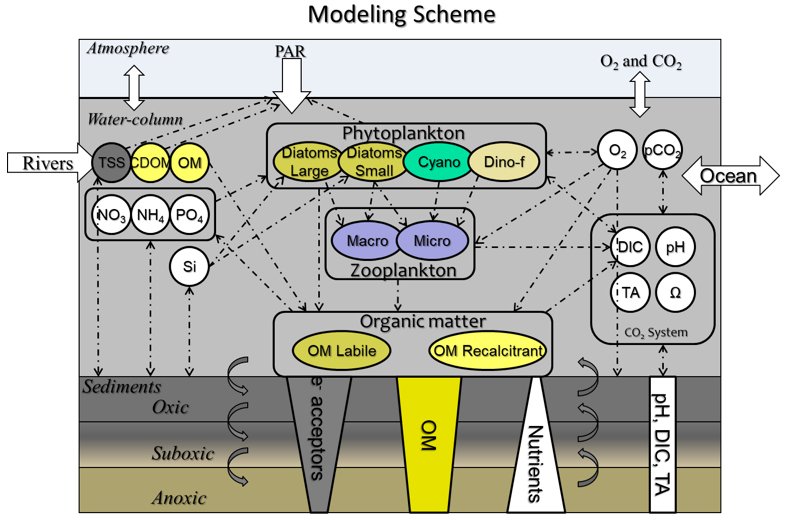Coastal Generalized Ecosystem Model (CGEM)
On This Page:
- What is the Coastal Generalized Ecosystem Model (CGEM)
- Water Quality Models Included in CGEM
- Who should use CGEM?
- What can CGEM be used to do?
- How does CGEM work?
- CGEM details
- Hydrodynamic Model Linkage
- System Requirements
- Model Installation Information
- Contact
What is the Coastal Generalized Ecosystem Model (CGEM)?
The Coastal Generalized Ecosystem Model (CGEM) is a biogeochemical model designed to address eutrophication, dissolved oxygen, and acidification dynamics in coastal and freshwater ecosystems. CGEM simulates biogeochemical processes regulating carbon, oxygen, nutrients, phytoplankton, and zooplankton, and includes numerous model formulations and variable phytoplankton functional types that can be modified based on site specific model requirements. CGEM also provides users the option of a full sediment diagenesis model as well as formulations representing carbonate chemistry and pH necessary to address acidification and global climate change. CGEM includes two water quality modules that are available to the user within a single codebase. CGEM has been successfully implemented in coastal ecosystems ranging from the Louisiana Continental Shelf to small shallow embayments.
Water Quality Models Included in CGEM
CGEM includes two water quality modules that are available to the user within a single codebase. Users can switch between CGEM and the Water Quality Eutrophication Model (WQEM) model formulations based on specific modeling needs. Differences between the two models are described in their respective model framework documentation.
Who should use CGEM?
CGEM is an open-source model designed for researchers and managers that need a flexible water quality model with multiple formulation options that can be adapted to a range of coastal and freshwater ecosystems. Interoperability with numerous hydrodynamic models and inclusion of numerous biogeochemical formulation options allow CGEM to address water quality modeling challenges across a range of spatial scales in coastal ecosystems.
What can CGEM be used for?
CGEM can be applied to investigate nutrient and eutrophication related issues in a diverse range of aquatic environments. As an open-source model, users can adapt and apply CGEM biogeochemical equations to any physical hydrodynamic model of their choosing. Users can also utilize the provided Environmental Fluid Dynamics Code (EFDC) Utility to link CGEM with EFDC hydrodynamic model output, as well as choose between a range of 0-dimensional to full 3-dimensional model options. Physical and biogeochemical processes included in CGEM and of interest to researchers and managers include:
- phytoplankton production and respiration (multiple functional types)
- dissolved oxygen
- nutrients (nitrogen and phosphorus species)
- zooplankton (micro and macro)
- organic matter production and respiration
- sediment processes (including a full diagenesis model)
- carbonate system dynamics
- light attenuation
How does CGEM work?
CGEM provides a simple text interface to parameterize model setup. Users choose between multiple model switches (i.e., varying phytoplankton temperature formulations, nutrient uptake options, etc.) and define values for biogeochemical rate processes. Model grid dimensions and initial conditions are also entered in text format. CGEM reads water column flows, vertical mixing coefficients, temperature, salinity, sea surface elevations, depth, layer thickness, boundary conditions, and river loads from NetCDF files. Simulation output from CGEM is in a NetCDF format. Users can extract and visualize data from NetCDF as needed and may also utilize a series of R scripts to visualize model data provided as part of the model download package.
CGEM details
The two water quality models included in the CGEM codebase offer multiple formulation options to implement water quality simulations in coastal and freshwater ecosystems. Detailed descriptions of model theory and formulations are provided in each model’s respective modeling framework documentation available in the CGEM download and documentation page. Select highlights of these model options include:
- Unlimited number of phytoplankton functional types that the user can specify as required (CGEM)
- Multiple zooplankton functional types (micro- and macro-zooplankton)
- Multiple options for light attenuation models (CGEM)
- Multiple sediment formulations are available of varying complexity, ranging from process-based fluxes to a full diagenesis model
- Simulation of carbonate chemistry (CGEM)
- Optional Droop or Monod (WQEM) nutrient uptake kinetics
Conceptual illustration of model variables and formulations included in CGEM

Hydrodynamic Model Linkage
Coupling of the Environmental Fluid Dynamics Code (EFDC) with CGEM/WQEM is facilitated by a stand-alone utility developed to post-process a hydrodynamic output file from EFDC, labeled with the suffix “.hyd.” This utility converts binary model output from the .hyd file into NetCDF formats required by CGEM/WQEM for advection and mixing in 1-D, 2-D, and 3-D models. Detailed instructions for the compilation and application of the EFDC utility is provided in the EFDC Utility User Guide.
System Requirements
- Linux operating system
- Fortran compiler (either Intel or GNU Fortran compilers are recommended)
- NetCDF v4 or greater
- pNetCDF (for parallel compilation)
Model Installation Information
See the CGEM Download page for information and links to access and download the CGEM source code, user guide, and model examples via GitHub. The CGEM model available for download on the CEAM website and via GitHub is subject to the CEAM distribution and support policy.
Contact
Comments or question regarding CGEM can be submitted through the CEAM contact page.
